Dominica
Written by Marla Archer
November 2011
|
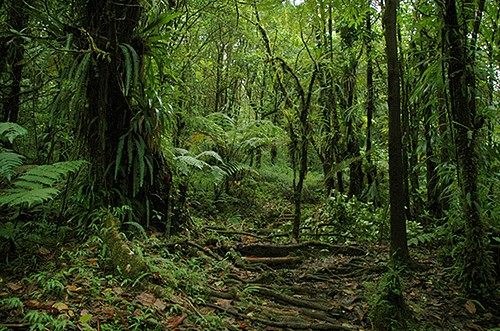 |
|
A Note from
Marla: The Caribbean island of Dominica is
practically the closest thing that you and I can come to
viewing nature in its most primitive form. The movie
Pirates of the Caribbean was filmed here on
this island for one simple reason: the utter lack of
civilization combined with breath-taking natural beauty made
it easy to find unspoiled background scenery.
I know that many
of our cruise group is dying to go to Hawaii and I promise
we will go there in 2013. However, in the meantime, Dominica
is just as lush and primitive as Kauai (Jurassic Park),
just as volcanic as the Big Island, and has just as many
waterfalls as Maui.
This island has
one amazing natural wonder after another... and, best of
all, our cruise to Dominica and the Eastern Caribbean costs
about half of what it will take to cruise to Hawaii.
So if you are
looking for something pretty wonderful to do over Spring
Break in 2012, think about Dominica!!
In particular, I
will be arranging a group shore excursion to view the
highlights depicted in the five locations I have written
about below:
- Morne Trois
Pitons National Park
- Trafalgar
Falls
- Titou Gorge
- Emerald
Pool
- Botanical
Gardens (seen on our way back to the ship)
If we get a
large enough group, based on my past experience I think we
can get a significant price break plus keep our group
together to share the experience. So I hope my
write-up catches your interest!
Marla Archer
|
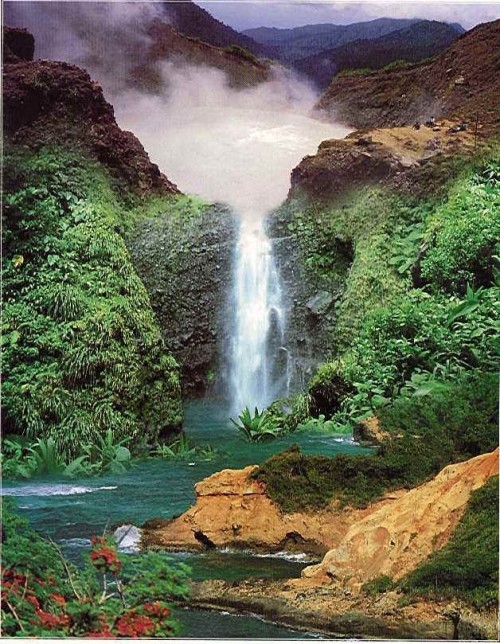 |
Morne Trois Pitons
National Park
Located in the south central part
of Dominica, this 16,980-acre park of primordial rain forest
contains the most spectacular hikes. Morne Trois Pitons
refers to the "mountain of three peaks" that rises to 4,672
feet. The legendary Valley of Desolation and Boiling Lake
hike is located within the park. This national park and
Unesco World Heritage site in the southern half of the
island in Dominica's mountainous volcanic interior.
Most of the park is primordial rainforest, varying from
jungles thick with tall, pillarlike gommier trees to the
stunted cloud-forest cover on the upper slopes of Morne
Trois Pitons (4550 ft), Dominica's
second-highest mountain. The park has many of the island's
top wilderness sites, including Boiling Lake, Boeri Lake,
Freshwater Lake and Middleham Falls. Hikes to all four start
at Laudat (elevation 1970ft), a small hamlet with fine
mountain views.
You won't see any large mammals in the park, but Dominica
does possess a wide range of insects, birds, crustaceans and
a few reptiles. There are four species of snake, all
non-poisonous.
A surprising characteristic here, as on most islands, is the
lack of bird calls in heavy forested areas at upper
elevations. Although 54 species of birds nest on the island,
the only one you're likely to hear on a steep climb is the
siffleur montagne, a mountain bird heard only in Dominica
and whose song has a striking clarity and sweetness.
Dominica is also home to 2 endangered parrots, the sisserou
and the jacquot. You're much more likely to see the
Antillean crested hummingbird and the purple throated
hummingbird.
At sunset or when it rains, the little (2 cm) tree frogs
known as the gounouge are responsible for the chorus of
piping sounds. A remarkable example of adaptation to its
environment, these are born as perfect frogs without an
aquatic, tadpole stage.
They don't have the luxury of a prolonged adolescence in
still, safe water: because the rivers are so swift, the
streams contain little food and the water flow is highly
seasonal. To survive, the gounouge must be born "standing up
and talking back."
The crapaud, or mountain chicken, is a bulky, solid frog
hunted for food and occasionally offered on hotel menus
during its season. Mountain chickens, which grow up to 15-20
cm, have been seriously depleted through over-hunting. I
can't comment on their taste since I've never had one but
they are considered a great delicacy.
|
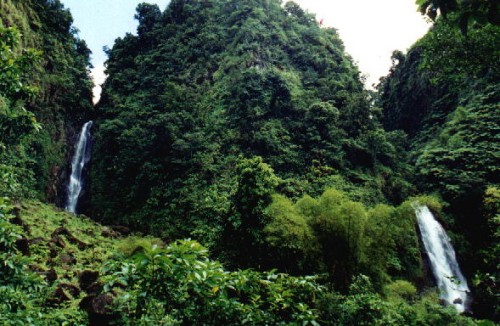
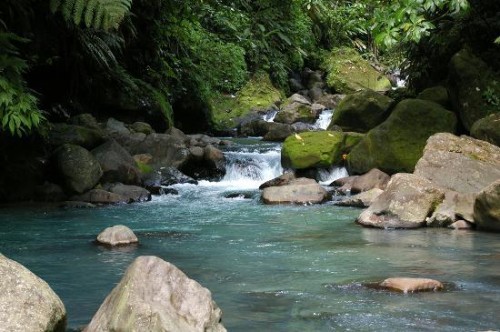
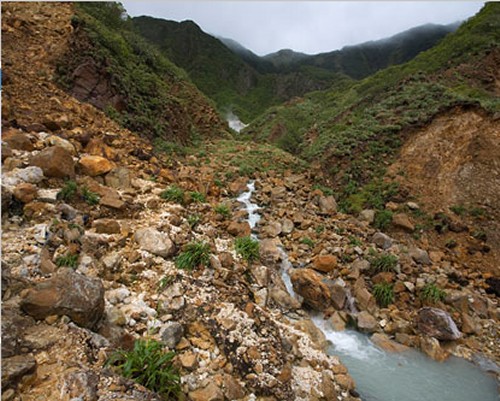 |
Trafalgar Falls
On the western edge of Morne Trois
Pitons National Park, Trafalgar Falls are spectacular and
accessible via a steep but smooth uphill walk. The 0.4-mile
walk to the falls begins at Papillote Wilderness Retreat,
about 1 mile east of the village of Trafalgar.
Start the walk at the bottom of the inn's driveway, where
you'll find a cement track leading east. Follow the track
until you reach a little snack bar; take the footpath that
leads downhill from there and in a couple of minutes you'll
reach a viewing platform with a clear view of the falls.
There are two separate waterfalls. Water from the upper
falls crosses the Titou Gorge before plunging down the sheer
200ft rock face that fronts the viewing platform. At the
base of the waterfall are hot sulfur springs. Look for
yellow streaks on the rocks to find a good soaking spot.
The lower falls flow from the Trois Pitons River in the
Boiling Lake area. This waterfall, gentler and broader than
the upper falls, has a deep and wide pool at its base made
for swimming.
The short trail has 3 lookout points. All illustrate just
how heavily forested and natural Dominica remains.
The first lookout is of Morne Trois Pitons. The second looks
across Belle Fille Valley and Morne Negres Marrons (2,248
feet). Part of the trail past the second viewpoint is paved
for a short distance.
This is part of the old track used as a main road by the
Carib Indians from perhaps 800 years ago to as late as the
1960s.
The third outlook shows the Atlantic Coast at Castle Bruce
and Anse Quanery.
If you happen to be here near twilight, enjoy the chorus of
tree frogs and crickets. Bats, too, will appear at that
time, helping to control the island's insect population.
|
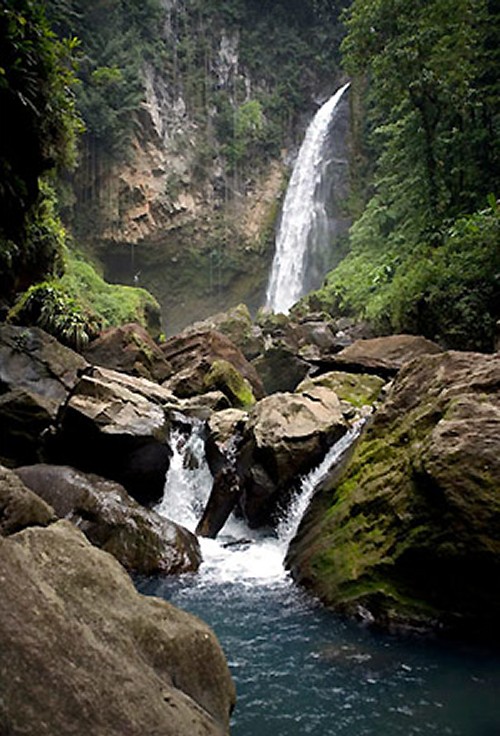 |
Titou Gorge
Titou Gorge is one of the Morne Trois Pitons National Park
attractions.
In 1997, it was recognized by UNESCO as a World Heritage
Site - the first enlisted Natural Site in the Eastern
Caribbean, and its inauguration was also marked with a
Regional conference on The World Heritage Convention.
This delightful spot is at the start of the hike to the
Boiling Lake. It is
fed by a small waterfall that
falls into a water-filled gorge ('Ti tou' means
'little-throat' in Creole).
Judging by all the pictures with people in the water,
apparently this place is safe enough for wading.
There's also hot water close by, making it also a refreshing
stop at the end of the hard Boiling Lake hike!
A narrow gorge in the heights of the Roseau River near
Laudat that became a source of water for hydro-electricity
from the early 1950s and a tourist attraction during the
late 20th century.
The name comes for the French
Creole for "little hole" or opening. The gorge is formed by
the action of water coming from the Freshwater Lake, which
over thousands of years has cut its way through the thick
layers of volcanic ash that compacted after the eruptions of
Morne Macacque (Micotrin). This form of rock is called
"welded tuff".
As the water cut its way through
this, it carved out pools and waterfalls over and around
harder rocks lodged in the tuff. At the end of the gorge the
water continued down river to cascade over the higher of the
two Trafalgar Falls. When CDC was constructing the first
hydro scheme in the 1950s, the mouth of the gorge was dammed
so as to divert the water into canals and pipes. This raised
the level of the water in the gorge so that it became a
popular experience to swim up the gorge and it is now one of
Dominica's tourist attractions.
|
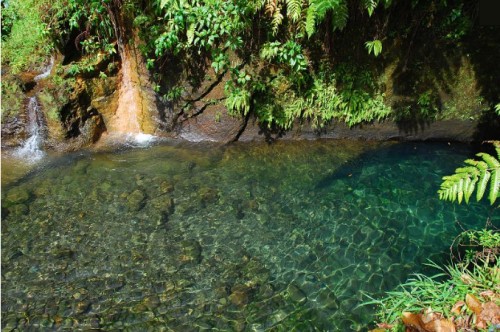
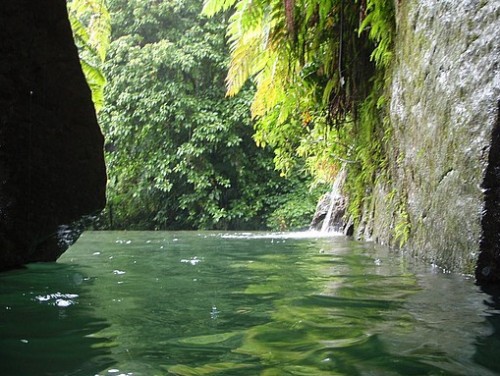 |
Emerald Pool
The easy walk to the Emerald Pool
is a loop trail of less than 1 mile that takes about 20
minutes to complete. Emerald Pool, only a 10-minute walk
from the road. This is a favorite stop on the way from
Roseau to the Carib Territory.
Emerald Pool is located 3.5 miles northeast of Pont Casse on
the road to Rosalie and Castle Bruce. Take the left fork
that goes to Castle Bruce. The small parking lot is
0.5-miles on the left.
Reached by a half-mile loop trail, the Emerald Pool is by
far the most accessible spot in the entire Morne Trois
Pitons National Park. Emerald Pool is actually a
waterfall-fed pool that appears bright green in the
tree-filtered sunlight.
The forest here technically falls into what is known as a
transition zone, not true rain forest or montane forest. The
majority of plants are young trees--not shrubs--which create
a massively thick canopy, prompting many vines to grow
upwards from ground level.
Others, established in the tree tops, send down their roots.
Epiphytes are especially fond of the filtered sunlight, and
the trees are covered with them.
Both the agouti, a guinea-pig-like rodent, and the nocturnal
manicou, a small opossum, live here, but you are far more
likely to spot birds, particularly hummingbirds, and hear
the song of the mountain warbler.
It's possible to swim in Emerald Pool; in fact, on a hot day
you'll probably want to. If you do, go stand behind the
20-foot high waterfall; there's plenty of room in the eroded
stone behind it. But be careful. The rocks are slippery.
The short trail has 3 lookout points. All illustrate just
how heavily forested and natural Dominica remains.
The first lookout is of Morne Trois Pitons. The second looks
across Belle Fille Valley and Morne Negres Marrons (2,248
feet). Part of the trail past the second viewpoint is paved
for a short distance.
This is part of the old track used as a main road by the
Carib Indians from perhaps 800 years ago to as late as the
1960s.
The third outlook shows the Atlantic Coast at Castle Bruce
and Anse Quanery.
If you happen to be here near twilight, enjoy the chorus of
tree frogs and crickets. Bats, too, will appear at that
time, helping to control the island's insect population.
|
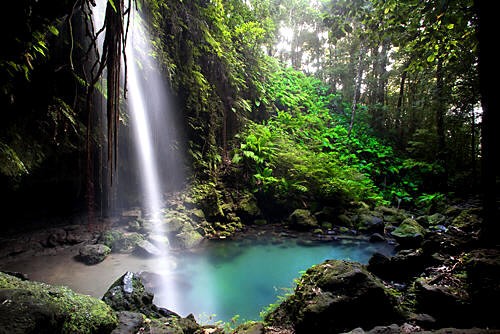
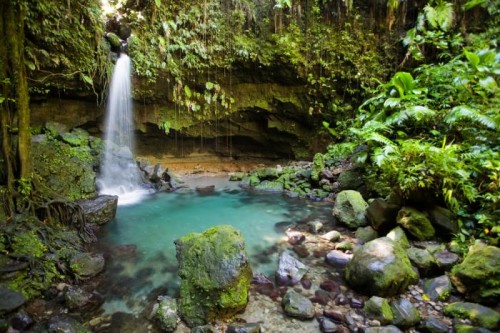 |
Botanical Gardens
Located in Roseau, these were reputed to be some of the most
beautiful grounds in the Caribbean until 1979's Hurricane
David, which did considerable damage.
Situated below the Morne Bruce Hill, the 40-acre tract is
the largest semi-open space in the capital city of Roseau ;
it served as a popular cricket ground in the 1960s and 70s.
Although just 68 feet above sea level, the gardens receive
more than eighty-five inches of rain annually, making them
an ideal site for growing a wide variety of tropical plants.
Originally a sugar cane field, the ornamental planting began
in 1890 and was beautifully landscaped with a fountain, iron
gates, ponds and 500 species of exotic and indigenous shrubs
and trees.
The most interesting site displays the remains of a large
yellow bus crushed beneath a massive baobab tree, an
ever-present reminder of Hurricane David's devastation. The
Forestry and Wildlife Division here offers "A Guide to
Selected Trees and Shrubs" to help identify plants.
An aviary contains 2 species of parrots, the imperial and
red-necked. The aviary is part of a captive breeding program
to increase the number of parrots in the wild.
Jack's Walk, which leaves from the gardens, will take you up
Morne Bruce for a panoramic view of Roseau.
|
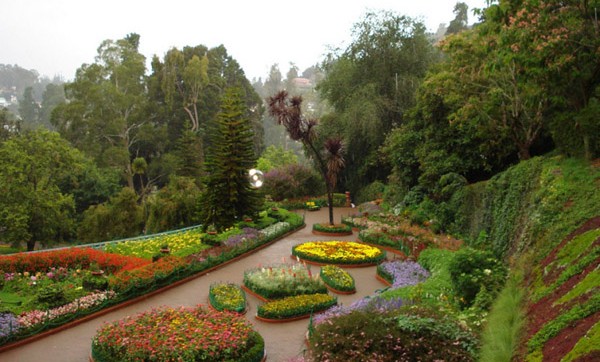
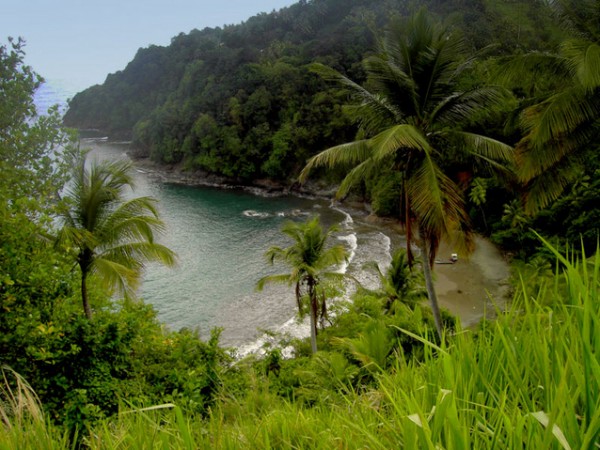 |
|